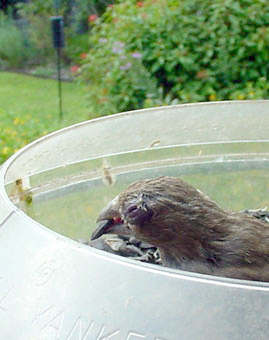 A
house finch at a feeder seems to be blind on one side. The eye is nearly closed.
The other eye looks red and wet. It is Mycoplasmal
conjunctivitis.
A
house finch at a feeder seems to be blind on one side. The eye is nearly closed.
The other eye looks red and wet. It is Mycoplasmal
conjunctivitis.Album of 50 Pictures of Diseases of House Finch and other finches in North America
1. House Finch Conjunctivitis
 A
house finch at a feeder seems to be blind on one side. The eye is nearly closed.
The other eye looks red and wet. It is Mycoplasmal
conjunctivitis.
A
house finch at a feeder seems to be blind on one side. The eye is nearly closed.
The other eye looks red and wet. It is Mycoplasmal
conjunctivitis.
They stay in the feeder as much as possible because once they leave they have a hard time returning. Without treatment from a licensed professional rehabilitator, they are doomed to starvation. Open platform feeders are used to avoid contamination from rubbing against feeding ports.
http://www.birds-n-garden.com/wild_birds_diseases.html
2. House Finch Conjunctivitis
http://s283.photobucket.com/albums/kk296/Paoniabirds/2010/?action=view¤t=P1020527lc.jpg

3. House Finch Conjunctivitis
 red
and wet eye http://www.aawv.net/
red
and wet eye http://www.aawv.net/
4. Female Purple Finch conjunctivitis
http://www.flickr.com/photos/79926959@N00/2325834262/
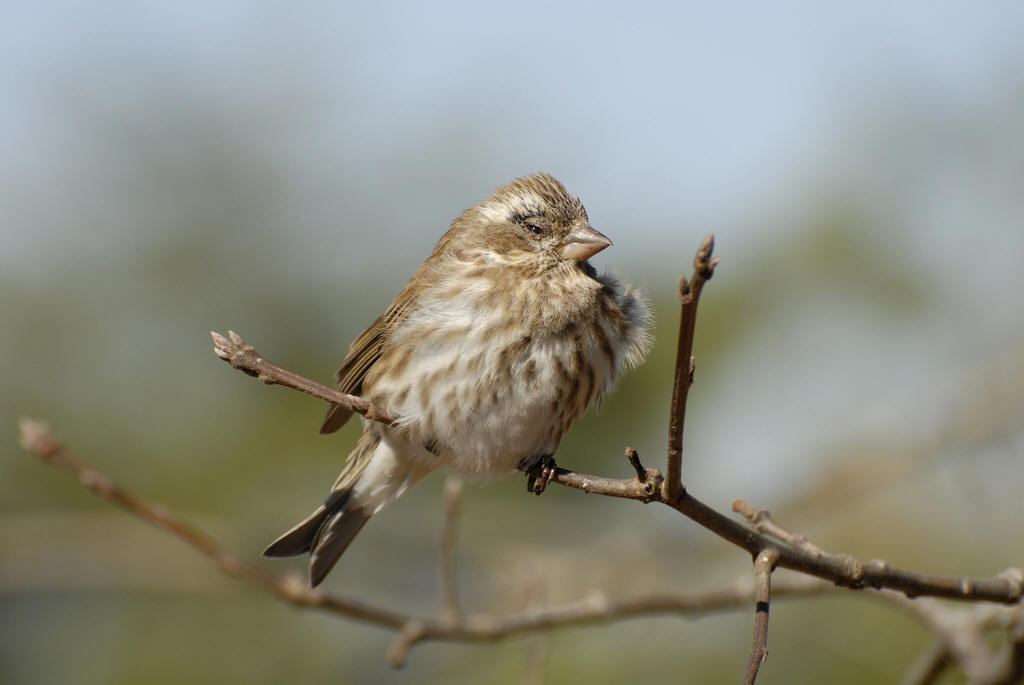 2008-03-09,
Ruckersville Virginia.
2008-03-09,
Ruckersville Virginia.
5. American Goldfinch with Conjunctivitis
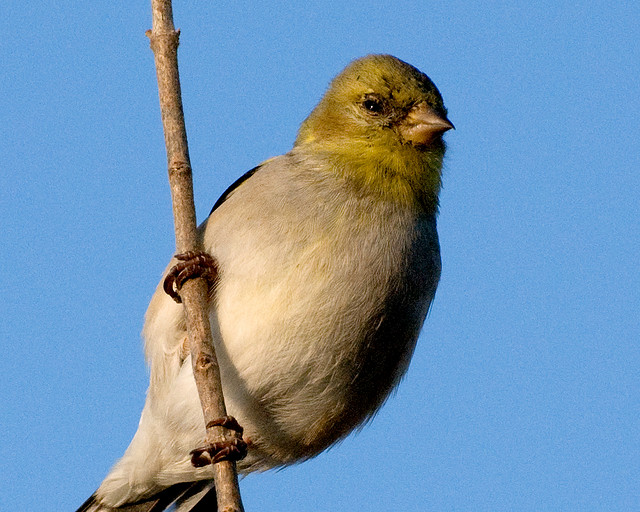
6. American Goldfinch with Conjunctivitis

http://www.flickr.com/photos/momcat14c/2340389881/
7. Mycoplasma gallisepticum
 http://cevr.uconn.edu/genome.html
http://cevr.uconn.edu/genome.html
8. Prevalence of Mycoplasmal Conjunctivitis
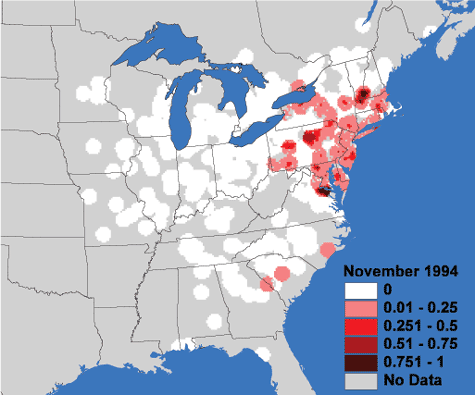 http://www.birds.cornell.edu/hofi/spreaddisease.html
http://www.birds.cornell.edu/hofi/spreaddisease.html
These maps show the prevalence of mycoplasmal conjunctivitis in House Finches from 1994 to 2002. Data are presented for the months of February and November, two periods of high disease prevalence each year. Prevalence is shown as the proportion of days that infected birds were seen by House Finch Disease Survey participants (relative to the total number of days that House Finches were observed). White indicates that no diseased birds were observed, and grey indicates that no observations were reported.
9. House Finch with Avian Pox
many pictures from http://www.birds.cornell.edu/hofi/recognizing.html
More about Avian Pox in birds in general: http://www.birds.cornell.edu/pfw/AboutBirdsandFeeding/DiseasedBirds.htm
10. Avian Pox In General
Avian pox is a slowly developing disease of birds caused by several different strains of avipoxvirus. A variety of birds worldwide, including upland gamebirds, songbirds, marine birds, and the parrot family can become infected. Raptors are occasionally affected, but the disease is rare in waterfowl.
Transmission occurs via direct contact with infected birds, ingestion of food and water contaminated by sick birds or carcasses, or contact with contaminated surfaces such as bird feeders and perches. The virus enters through abraded skin. Insects, especially mosquitoes, act as mechanical vectors.
Clinical/Field Signs
Avian pox can occur in two forms: cutaneous pox and diphtheritic or "wet" pox.
In cutaneous pox (the most common form), wartlike growths occur around the eyes,
beak or any unfeathered skin. This leads to difficulty seeing, breathing,
feeding, or perching. In diphtheritic pox, the growths form in the mouth,
throat, trachea and lungs resulting in difficulty breathing or swallowing. Birds
with either form of pox may appear weak and emaciated.
Lesions
The cutaneous form of pox causes warty growths on unfeathered skin, sometimes in
large clusters. The size and number of growths depend on the stage and severity
of infection. Common sites include feet, legs, base of beak, and eye margins.
Birds are often emaciated due to inability to feed. In the diphtheritic form,
there are raised, yellow plaques on the mucus membranes of the mouth and throat.
Wildlife Management Significance
The disease can be a significant mortality factor in some upland game bird
populations during fall and winter months, in songbirds over winter, and in
raptor populations. Birds can survive with supportive care, food and water, and
protection from secondary infections. Warty scabs contain infectious viral
material. Disease control recommendations are site specific, therefore contact
the National Wildlife Health Center for assistance. Decontamination of bird
feeders, birdbaths, transport cages and banding equipment with 10% bleach and
water solution is recommended. In some situations, removing infected birds can
be important to reduce the amount of virus available to vectors and noninfected
bird populations. Vector control may be considered in affected areas.
For more information on Avian Pox, please contact: Paul Slota, USGS, National Wildlife Health Center at 608-270-2420.
http://www.nwhc.usgs.gov/disease_information/other_diseases/avian_pox.jsp
11. Diseases of Pet Finches
http://www.avianweb.com/finchdiseases.html
Feather Loss:
Stress:
The most common cause of feather loss in finches is stress.
Is there another bird that is harassing him or her? If so, then separating may help. Rivalry can particularly occur during the breeding season.
Other than external factors, it could also be malnutrition that is causing stress on a bird's system. The recommendations then are to improve diet (a good quality dry finch mix, egg food, such as mashed boiled egg with the shell, grated carrots, greens like cucumber, cabbage, and herbs, etc. - more info on this page: http://www.avianweb.com/finchcanaryfood.htm ...
increase sunlight exposure (to naturally increase Vitamin D, also known as the sunshine vitamin)Parasites:
If several birds were losing feathers, one would suspect a possible worm and/or protozoal infections, which would need to be treated. Less likely if it's only one finch.
Iodine deficiency:
Particularly common in Australian finches, but not exclusively so. Iodine is required for the proper functioning of the thyroid gland. Iodine deficiency can result in poor feather condition, difficulty molting, breathing and infertility problems. Particularly Australian finches (such as Gouldian's) have a higher requirement for iodine. Iodine can be provided by adding grated cuttlebone on their greens, sprouted seed or egg food supplements. Oyster shell is another great source of iodine. If natural food sources are not enough, then the next step would be to supplement with Liquid Iodine, Natra-Kelp or Powder Kelp. However, natural food sources are always safest and should be fed first, before using supplements. Balding pattern in most cases on the head. If after 3 weeks of supplementing the feathers are not coming back, iodine deficiency is not the cause.
Hormonal / Breeding: Feather loss can also be caused by hormonal problems in hens or breeding birds out of season.
Feather Loss from Head- Feather mites or aggression by other birds in its environment.
Respiratory Signs, Chronic Depression, Weightloss: Aspergillosis (fungal disease), bacterial infections / pneumonia, nutritional deficiencies (Hypovitaminosis A), air sac mites (Gouldian Finches), upper respiratory tract infections (bacteria, mycoplasma), Polyoma Virus or inhaled toxins.
Genetic Diseases - Affecting primarily mutation and/or in-bred finches (Gouldians / Zebras)
Masses on Legs and Feet (Scaly Leg Disease) - can be caused by Knemidokoptes mites (especially European Golf Finches), swelling from strangulated fibers or insect bites.
Eye Problems / Conjunctivitis: Herpes virus infection; Mycoplasmal Conjunctivitis or Blepharitis
Scaly Legs - Knemidokoptes mites, but may also genetic or nutritional
12. Aspergillosis
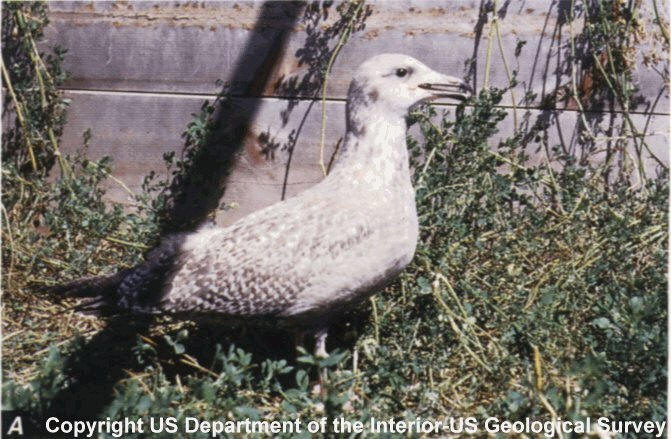 A
disease of the respiratory tract, primarily of birds (infects humans too). It is caused by a
fungus, Aspergillus, usually A.
fumigatus. A bird becomes infected by ingestion or
inhalation of mold spores from contaminated foods, especially moldy peanuts or
corn.
A
disease of the respiratory tract, primarily of birds (infects humans too). It is caused by a
fungus, Aspergillus, usually A.
fumigatus. A bird becomes infected by ingestion or
inhalation of mold spores from contaminated foods, especially moldy peanuts or
corn.
http://www.unbc.ca/nlui/wildlife_diseases_bc/aspergillosis.htm
http://www.iowadnr.gov/wildlife/diversity/files/newsletter_09spring.pdf
Laboured breathing and gaping are often observed in birds suffering from aspergillosis.
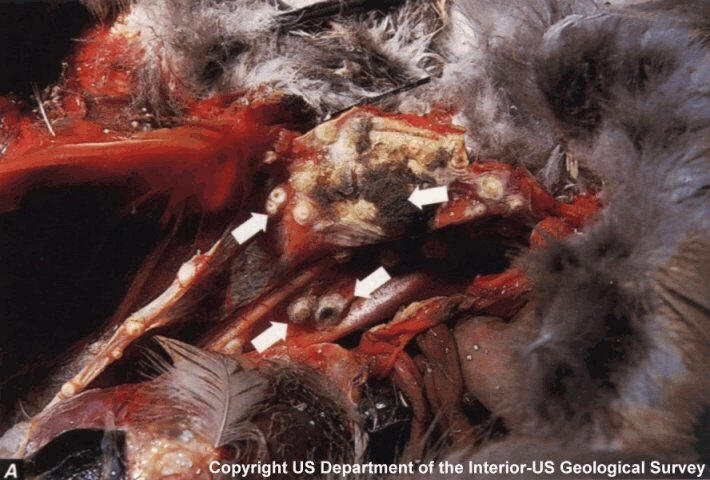 Lung of bird with chronic aspergillosis showing "cheese-like" fungal plaques (at
arrows).
Lung of bird with chronic aspergillosis showing "cheese-like" fungal plaques (at
arrows).
More: http://www.avianweb.com/aspergillosis.html http://www.avianweb.com/sickbirdsinthegarden.html